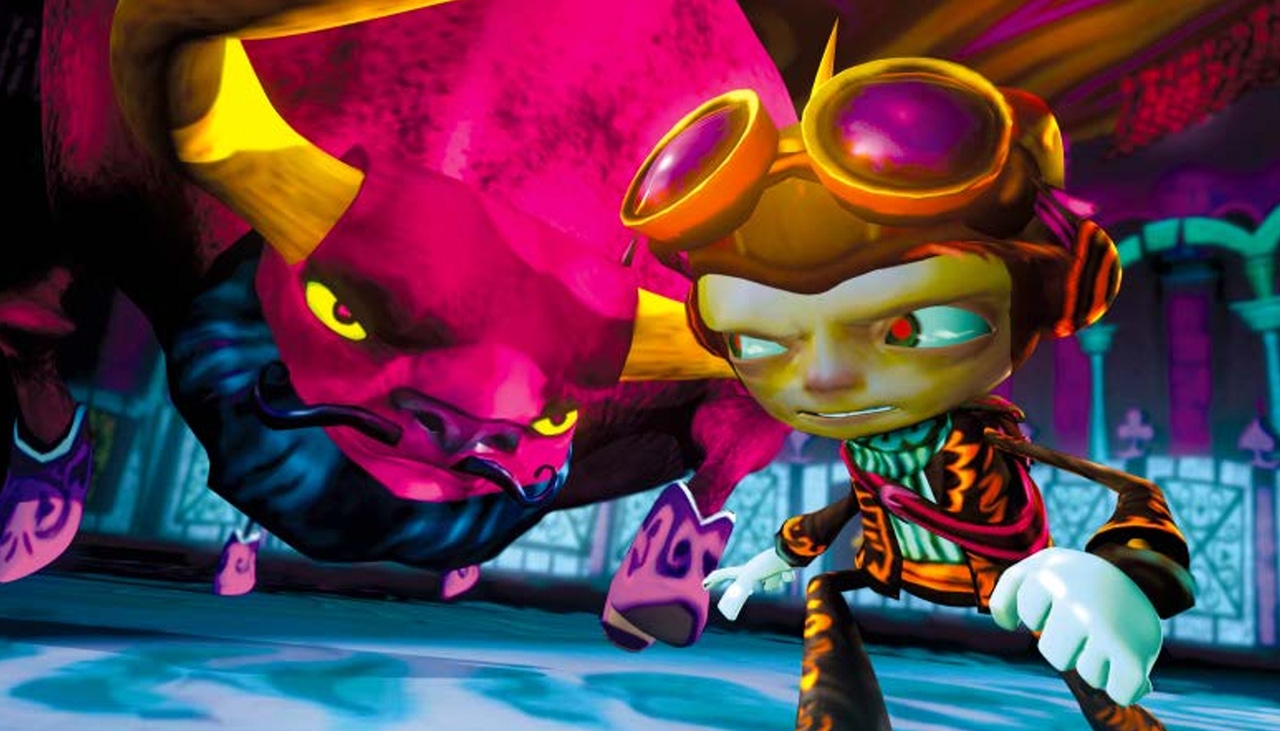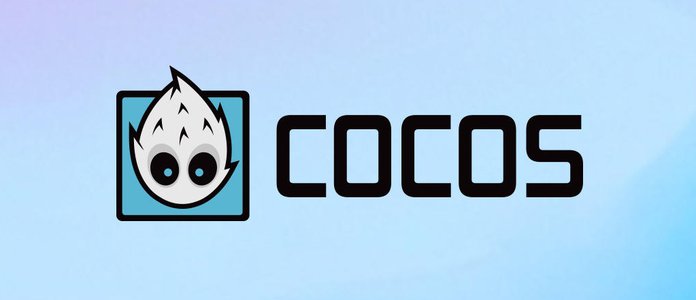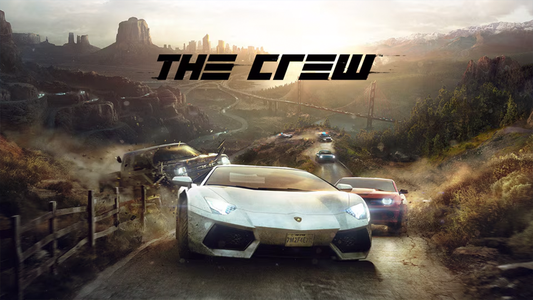
Ten years ago, the most mind-bending action platformer ever devised was released. Psychonauts, which let players explore the mindscapes of an array of bizarre characters, featured some of the most inspired writing and level design in the history of the medium. Caroline Esmurdoc, who was the executive producer on the game, provided a detailed postmortem for the August 2005 issue of GDMag. To celebrate the game's tenth anniversary, we're running that entire article online for the first time ever. Enjoy! (Just beware of the Milkman...)
GAME DATA
RELEASE DATE April 2005
PUBLISHER Majesco Entertainment
GENRE Third-Person Action/Adventure/ Platformer
PLATFORMS Xbox; later ported to PC (internally), and PS2 (by Budcat Creations)
PROJECT BUDGET $11.8 million
PROJECT LENGTH 4.5 years
LINES OF CODE Game: 166,781 lines in 381 files in C++. Game Script: 332,650 lines in 2,433 files in Lua. Tools: 81,260 lines in 445 files in C++/C#; 11,318 lines in 51 files in Python.
PEAK TEAM SIZE 42 full-time developers, 5 contractors.
HARDWARE USED Xbox dev kit, Dual Xeon 2.66 GHz, 1GB RAM, Nvidia GeForce 6800GT
SOFTWARE USED Maya, Photoshop, Premiere, Lua, Python, Emacs, Visual SlickEdit, XACT authoring tools, Perforce, Visual Studio.Net, MoinMoin Wiki, Bugzilla, Bink Video SDK, Microsoft Xbox XDK
Double Fine was born to develop original, genre-defining games based on the imaginative outpourings from the mind of its founder, Tim Schafer—the first of which was Psychonauts. Double Fine did many things right, such as boundlessly tolerating creative risk and exploiting the strengths of the company in its product. But the company also suffered perilous setbacks that threatened its survival. With no precedent to guide us through the problems that arose, we relied on our prior experiences and a collective desire to be successful. Some times, however, our successes during the game’s production seemed like they could be defined as “repeatedly snatching victory from the jaws of certain defeat.”
In 2001, during the dot-com boom, the only San Francisco work space we could afford was a warehouse on Clara Street. There was a rough and ready start-up vibe to the place; it was really great for parties, and big enough that we could actually drive our cars into the warehouse and park next to our desks.
But the neighborhood was not the safest. Cars were broken into repeatedly. One night, a woman from the transient hotel next door jumped out a fifth floor window and landed on our roof, breaking her leg and knocking a hole in our ceiling. Another day, there was a dead body in the doorway across the street, apparently the victim of an overdose. Inside, there was no heat (space heaters would blow the circuit breakers). Rats made themselves comfortable in our offices, and even worse, on rainy days the sewers under the office would expel through the latrines, onto the floors, and through the halls. What started as punk-rock charm soon became depressing, disgusting, and dangerous.
By July 2003, office space had become affordable again—outrageously cheap, in fact. So we packed up and moved into our current climate-controlled, industrial, loft-like space.
As if deplorable office conditions weren’t enough, we also faced impossible deadlines. One early publisher milestone required that we demonstrate multi-pass effects before the renderer was completed. In another case, it was only after a milestone had been submitted that we learned of content that was required before the delivery would be approved and a payment released. Eventually, our schedule began to slip as well.
Just prior to our office move, we amended our publishing agreement to move out the ship date. The new contract stipulated that within three months we hire a producer and develop a build of the game that demonstrated the fun factor of the finished product—or risk cancellation. I joined the team as executive producer in the middle of this trial in the summer of 2003.
With new management in place, and everyone focused on one game section for three intense do-or-die months, the Black Velvetopia level emerged as one of the most innovative expressions of the Psychonauts gameplay experience. It was well received by our publisher who renewed its green-light decision. We spent the next several months developing multiple levels of the game concurrently at an unprecedented pace.
In February 2004, at what seemed to be our peak productivity, a time when we felt most confident about shipping on schedule, Microsoft decided to discontinue its development of Psychonauts. Microsoft had funded years of mistakes, course corrections, and learning curves, but it drew the line at underwriting the remaining game development now that Double Fine was finally on track. When Ed Fries departed Microsoft, the new management seemed to think that we were expensive and late. The assessment was accurate, though it did not reflect the progress we were finally making toward shipping the game and recovering the development investment.
It took all of our savings, careful money management, and a little help from our friends to survive the cancellation. We continued to work hard on milestone builds, though we had no publisher to submit them to. Tim and I focused on securing new funding.
Psychonauts was met with resistance from some publishers and faced internal political struggles in getting green-lighted by others. It was a demoralizing time, compounded by the stress of being completely honest with the team while still motivating them to continue to meet scheduled deadlines. After several trying months, and with our coffers running dry, we prepared the team for the worst. Though it was hard for them to hold out hope, they continued to toil. Our determination finally paid off. In July 2004, Majesco offered us a publishing deal.
The new publishing terms meant foregoing additional planned hires without the benefit of scaling back the design. The convergence of these factors led to the most insane crunch I have ever witnessed. We all worked ourselves beyond what was reasonable and humane—yet the team remained loyal and steadfast. In March 2005, Psychonauts went gold. We had managed to dodge a hundred bullets without compromising the quality of the game, losing ownership of the company, or missing a single day of payroll. Through a series of setbacks and disappointments that would have decimated other groups, the Double Fine crew displayed an unshakable spirit, resulting in the creation of one of the most cohesive teams I’ve ever seen. Solidarity like that is not something that can be recruited, but only forged in fire. It is because of them (and their patient, tolerant, and supportive families) that I can write this postmortem.
WHAT WENT RIGHT
1) STRONG GAME VISION AND UNCOMPROMISING QUALITY
Since the company’s inception, Tim had an idea to make a psychic action/adventure game whose levels were located in a character’s mind, locales where the surreal visuals would immerse players in the mental state and back story of that character.
In his inimitable style, Tim crafted a storyline that weaved together the relationships between a collection of psychic children and their camp leaders with the minds of the misfits, monsters, and madmen that held the clues to saving the world from total annihilation. The environments were fantastical, the characters were memorable, the gameplay was inspired. The use of psychic powers as the tools by which the player progressed in the world was an innovative and uncontrived scheme in these settings. Each piece of the high concept fit together to make a cohesive whole, which survived intact through the project’s entire development.
An oft-uttered mantra at Double Fine is “God is in the details.” Psychonauts is a shining example of a game that got the details right. So many design ideas that at first seemed like they’d be insignificant to the player—or elements that would be easy to cut if time ran out, or other things not worth the performance or memory hit—turned out to be the features that make Psychonauts so appealing and memorable. Each detail presents itself as a beautiful little discovery, and collectively, they make the game much deeper. Details are one of the hallmarks of a Tim Schafer title, and Psychonauts is no exception.
2) RASM
Early in development, a strike team called RASM was formed. RASM stands for Raz Action Status Meeting, but eventually it meant something more concrete: a concentrated collection of team members tasked with ensuring that the main character’s core movements and actions felt exactly right.
RASM was successful because of the composition of the strike team and the frequency with which the meetings were held. The cross-functional group included at least one participant from each discipline on the team. At RASM, the designer described how he would use the action element in the level. The animator discussed how to exaggerate the character’s movement. The programmer demonstrated new functionality and tweaked the implementation in response to group feedback at the meeting. A test level containing each of the action elements was created to assess the look and feel of each movement. Each bi-weekly meeting was dedicated to one action element, with some movements requiring multiple discussions. Over the course of development, Raz’s full complement of core movements emerged. The feel of the main character is important in any game genre, but is especially important in a platformer. The RASM team did character movement in Psychonauts especially right.
3) TOOLS, TOOLS, TOOLS
Three noteworthy tools had profound effect on the development of Psychonauts.
Dougie and the Debug Interface. We chose to use an off-theshelf scripting environment to write much of the high-level game code, wanting fast feedback without having to compile the game and an easy debug interface where we could enter commands and inspect in-game object states. We selected Lua for its small memory footprint, fast performance, and flexible environment that allowed us to add features such as class inheritance and cooperative multi-threading without digging deep into the language runtime. We wrote a remote native debugger, Dougie (named after a neighborhood homeless conspiracy theorist we befriended), to be able to inspect and use the features we wrote on top of the Lua language. In addition to traditional debugging features (e.g. break points, single stepping, and stepping over functions), we added object watch windows, profiling tools, hot script reloading, custom scripting buttons, and a command line console interface to the game. We wrote the platform-agnostic Debug Interface to standardize the user interface and facilitate the extraction of debug information, allowing automated control of the game by other proprietary tools and the flexibility to embed connections to it in other third-party tools, such as Maya, Python, and Emacs. It was fortuitous that we developed such powerful tools even before we knew just how much of the game we would be custom crafting in Lua.
Automated Build Process. Our automated build process (ABP) made a build of all SKUs of the game along with some of our tools. The ABP released automated builds at least daily, freeing the programmers from having to build and post versions of the game for the team regularly. It ran a test build in a clean environment based only on code that was checked into source control, provided immediate feedback to the programmers about changes included in the build, and reported any compile errors that resulted from the build (which were fixed immediately). The ABP saved countless hours of programmer time, especially as the team size expanded.
Cutscene Editor. Psychonauts has a colossal number of ingame cutscenes. Prior to the creation of this tool, the Gameplay Programmers (GPPs) would hand-craft each of the cutscenes. Needing a less cumbersome approach, we created the Cutscene Editor, which made scene creation much easier. The Cutscene Editor displayed a visual timeline, divided into columns of dialog lines and setup/cleanup sections, as well as rows of “actors” for each scene. In each actor, you could place an action at a specific time to play animations, place and orient a camera or actor, set actor properties, or even call Lua functions. Placement information could be read directly from the game running on the Xbox, and the cutscene could be previewed at any time. The Cutscene Editor rightfully put control of the scripting in the hands of the programmers and put control of the cinematography in the hands of the animators—and it saved countless hours or work.
4) ART DIRECTION AND HUMOR
Psychonauts reviews consistently praise the art direction and the humor, which is a gratifying reflection of the priorities and strengths of the company. Tim recruited artist Scott Campbell after seeing his work at an art show. Scott’s drawings had a subtle and understated cartoony look, something never seen before in games. Scott drew hundreds of loose, 2D sketches for Psychonauts, which our modelers turned into beautiful 3D geometry.
Many factors contribute to the success of the humor in Psychonauts—the art, the animations, the voice acting and, of course, the dialog. Tim wrote most of the dialog in the game himself, but enlisted the help of Erik Wolpaw (www.OldManMurray.com) for much of the script. The collaboration between the two was so successful that it’s nearly impossible to tell which of them wrote any one of the more than 8,000 lines of dialogue.
The script was brought to life by dozens of extremely talented voice actors. Animators hand-crafted scores of animations for the characters, conveying the humor of the dialog in the expressiveness of their movements. It’s rewarding to read players’ reactions to the characters and dialog in online forums, some even using game characters as avatars and game quotes as signature files. To us, that means we did the art and humor right.
5) HIRING SMART: GAMEPLAY PROGRAMMERS AND THE TEST DEPARTMENT
Originally, we staffed a team of level designers to script the game events, believing the scripting burden was simply a matter of placing some triggers. We soon learned that to make the unique cinematic experiences come to life, much more scripting was required. It wasn’t long before the level designers spent entire days bogged down in Lua. Though tech-savvy, they were not programmers. The code they generated was complex, buggy, and ultimately unusable. So, eight gameplay programmers were hired to rewrite the entire Lua side of the game from scratch. Staffed with experienced industry programmers and fresh college graduates from Computer Science departments, this group was one of our most critical (and overworked) ones, contributing profoundly to the design and quality of the game.
We founded an internal test department to shift the burden of stabilization away from the development team. Due to the highly dynamic codebase and limited reuse of scripted elements, continual regression was necessary to ensure that new features did not break existing code.
The ever-increasing game size, however, made it unreasonable for us to play through the entire game to test each change prior to check-in. We needed ongoing testing with up-to-the-minute assets but had no funds with which to hire a test team in light of our cancellation.
Undeterred, we put out a call for volunteers on our web site. And they came, friends and strangers, all willing to commit unpaid hours to the Psychonauts testing cause. The immediate and lasting benefits of an internal volunteer test team were so positive that we hired a full-time test department as soon as we signed with Majesco. Though few developers house an internal test team, we never felt having one was an indulgence. The test efforts led to consistently stable builds and greatly influenced our shipping product.





































